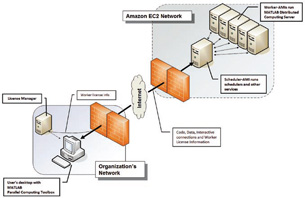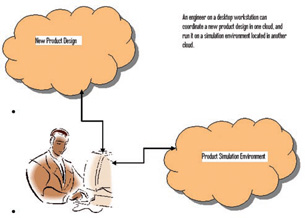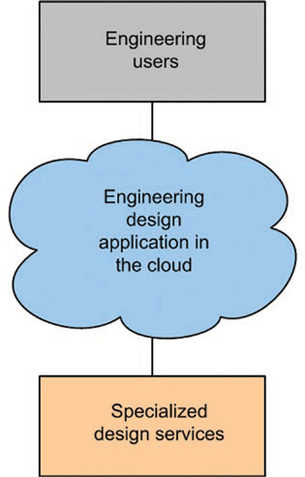Supercomputing and the Cloud, 1 in a Series
Information the engineering community needs to know about the cloud: Web services, hardware, and programming tools are just a few of the important considerations.
Latest News
January 27, 2009
By Peter Varhol
 Cloud computing enables engineers to leverage high performance computers on the Internet “in the cloud” to run applications or to access specific services such as simulation environments. |
Page 1 | 2 »
The latest buzz in enterprise computing today surrounds cloud computing. Rather like a cloud, the term itself is vague and subject to interpretation, and there is no succinct definition of just what it encompasses. Software as a service (SaaS) can often be considered to be coming from the cloud, commercial Web services are accessible through the cloud, and grids might be used to execute those services. But much of cloud computing is still being defined, and its perceived benefits are in the process of being digested.
The cloud is, of course, the Internet and a combination of the public and private infrastructure behind it. It also refers to the ability to run applications or application components at some indeterminate location on the Internet and make them available to end users. Specifically, cloud computing architectures are offered either free of charge or for a subscription fee by a number of vendors, including Amazon, Google, Microsoft, and Yahoo.
While the cloud has connoted a single entity that in some manner is accessible to applications and users, in fact the best metaphor might be a partly cloudy day, during which there are many clouds of different sizes in the sky. Some of these clouds float apart while others are touching one another.
You can use an application designed to run on a local server, and call on a single cloud or multiple clouds for specific services, for example. Or you can package up that local server into an image (using an application like VMware, for example), send it up to a cloud provider, and run the entire application off one or several clouds.
 Fundamentally, engineers can call design applications on more highperformance computers in the cloud. Those computers can call specificapp components to perform tasks such as simulation or stress analysis. |
Clouds We Know
Perhaps the best known cloud today is Amazon’s Elastic Computing 2 (EC2). EC2 is strictly capacity; you take your VMware image, pack it up, load it onto the piece of the EC2 cloud you have purchased, and you have that virtual computer and its applications or services on demand. There are a couple of advantages to this approach. One is that enterprises and even individual teams don’t have to budget for substantial hardware purchases. Rather than making a single large purchase for servers, SANs, and associated hardware, the organization writes a check for a known and stable amount to the cloud provider.
Another advantage is that the enterprise is, in effect, outsourcing IT promises. Service-level agreements, along with maintenance, upgrades, and support are placed into the hands of a single professional staff whose sole responsibility is to reliably deliver that computing capacity.
But it is strictly an IT solution rather than an engineering opportunity. A cloud such as EC2 holds some interest for the engineering community because it can deliver high capacity during times when it is running simulations.
Microsoft offers a combination of services and a programming interface to access those services in Microsoft Live. These services include Virtual Earth, Windows Live ID, and Silverlight streaming. Today they are mostly free, but because Microsoft still (after more than two years) considers them in beta, don’t expect to have the kind of service level agreements you need for production applications.
 An engineering computer can use the cloud to access data and specific applications that may be rented for occasional use, rather thanpurchased outright. |
Of course, Microsoft has also just announced Azure, its “live framework” for computing in the cloud. In essence, it provides a version of the .NET framework that can be called from the Internet by applications running locally. Azure is a combination of Microsoft services that can be called from the cloud at dev.live.com. Currently in pre-beta, it is available for experimentation by developers interested in learning more about these services.
For design engineers, using a value-added cloud such as Azure, traditional design applications can be combined with other services, such as standalone simulation environments to make design, modeling, and simulation a single integrated activity rather than discrete steps. And rather than owning all of the tools to make that happen, an engineer can rent the services as they are needed during the design cycle.
The result is that there is increasing acceptance of cloud computing by this leading-edge community, and thus the rapid adaptation of tools to enable HPC users to take advantage of computing power in the cloud. This trend bodes well for general-purpose computing in the cloud, as industry-standard hardware and software are becoming key components of HPC.
Page 1 | 2 »
Subscribe to our FREE magazine, FREE email newsletters or both!
Latest News
About the Author
Peter VarholContributing Editor Peter Varhol covers the HPC and IT beat for Digital Engineering. His expertise is software development, math systems, and systems management. You can reach him at [email protected].
Follow DE





